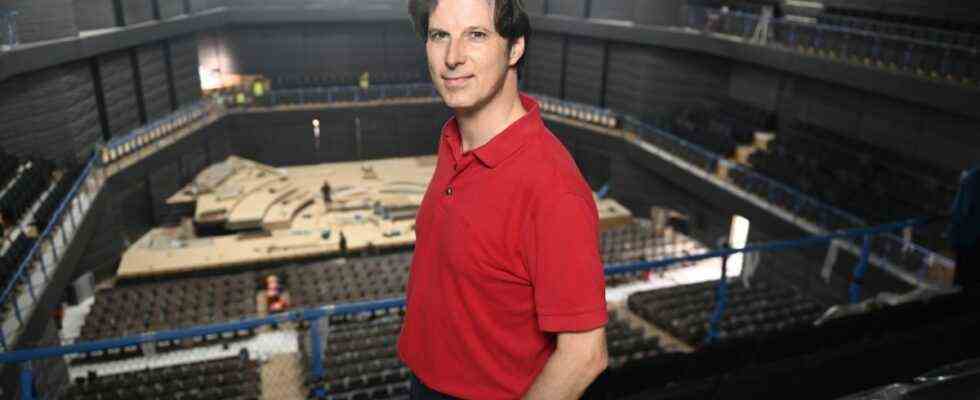Rhythmic hammering, grinding, singing saws. The usual cacophony of noise still echoes through the room, but the construction site is well advanced. The armchairs wait for their owners to change every evening under crackling protective covers. The stage with its ingeniously retractable step platforms stands out in light Canadian maple from the almost black-stained wood of the room. “Overwhelming,” says Daniel Müller-Schott. “I can already feel the applause.” For a moment the cellist takes off the yellow plastic helmet that says “Der Neue Gasteig”.
Daniel Müller-Schott knows the big concert halls from Sydney to Berlin, from Tokyo, Moscow, New York, Los Angeles, Bogotá to Paris. He came to the construction site tour with Max Wagner, the Gasteig boss, on a bicycle with a child seat on the luggage rack. Clearly too small for his cello, the “Ex Shapiro”, which Matteo Goffriller made in Venice in 1727.
Plenty of protection: the helmets for construction workers and visitors are labeled “Der Neue Gasteig”.
(Photo: Catherina Hess)
Fortunately, in the unfortunate event of the pandemic, the 44-year-old has heard of two canceled tours in Asia and America this season for moments like these. He has never been to any other concert hall construction site. But he dares to make a prognosis from the gut. “Something really big is emerging here”. And by that he doesn’t mean the volume of the room. “The room already has a great atmosphere. For me the most important thing when I’m on stage is to have this concentration, the focus on the music, and at the same time to feel the connection to all the people who are listening. I have the impression that this can work particularly well here. “
The distances from the stage to the seats up to the back rows seemed short to him, and the seats behind the stage were also very well connected. As a musician in the Elbphilharmonie vineyard, he always got the impression: “Everything around me somehow works.” Although he certainly appreciates the acoustics of the Elphi, “for its clarity, you can hear every orchestral voice clearly in the audience”. The acoustics for the “Iphie” were designed by the same man, the Japanese Yasuhisa Toyota. “You can only speculate about that at the moment, of course,” says Müller-Schott. “But I believe that the acoustics will have a certain warmth that I also hope for. Because many modern halls lack that compared to the old ones, such as the Concertgebouw or the Musikverein in Vienna.” The large amount of built-in wood and the shape of the hall promise a certain “intimacy”. Müller-Schott is looking for the center of the stage – a technician with a smart T-shirt from the company “Bühnenbau Wertheim” whirls around him with a cordless screwdriver.
In the loneliness of the forest: Daniel Müller-Schott with his ex-Shapiro cello from 1727.
(Photo: Uwe Ahrens)
“That the stage is not as high as, for example, in the Herkulessaal, where the sound literally goes over the first rows, should also be helpful.” He looks at 1900 places that the room holds. “It seems very compact to me. The Sydney Opera House looks really spectacular from the outside, but inside it is much too big, you had to help out with all sorts of tricks from the acousticians,” he says. “Even the empty chairs look cozy to me here.” The overall picture is ideally suited to the location for which it is intended: “It represents the warmth of the city.”
And it also stands a bit for Munich’s good financial opportunities and the appreciation it shows its Philharmonic Orchestra. The orchestra should find a home here for at least seven years. This interim philharmonic orchestra costs around 40 million euros, to which the Bavarian Radio Symphony Orchestra and private concert events are also moving. According to politicians’ wishes, it should also remain standing when the Gasteig in the city center is ready for occupancy again. The 40 million are more than half of the costs for the entire planning and construction of the alternative quarter HP8 in Sendlinger Hans-Preisinger-Straße, which are calculated at around 70 million.
The historic brick hall forms the foyer of the Isarphilharmonie. The two buildings are – invisible from this perspective – connected by two ladders to heaven.
(Photo: Catherina Hess)
Work is also making significant progress in the historic “Hall E”, the brick building that will form the foyer of the Isarphilharmonie. The huge scaffolding that had been erected to repair the glass roof has given way. Downstairs, the counters for the bar and the library, which is always open, are already being marked out. And Daniel Müller-Schott goes back to his bike. This leads him past the interim building of the music college, which is also growing every day. By the time Schott comes back to play his first concert here on the premises, that will also be occupied.

